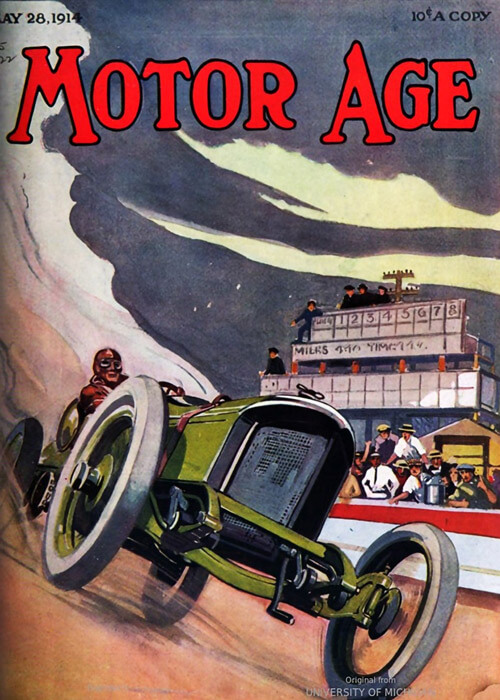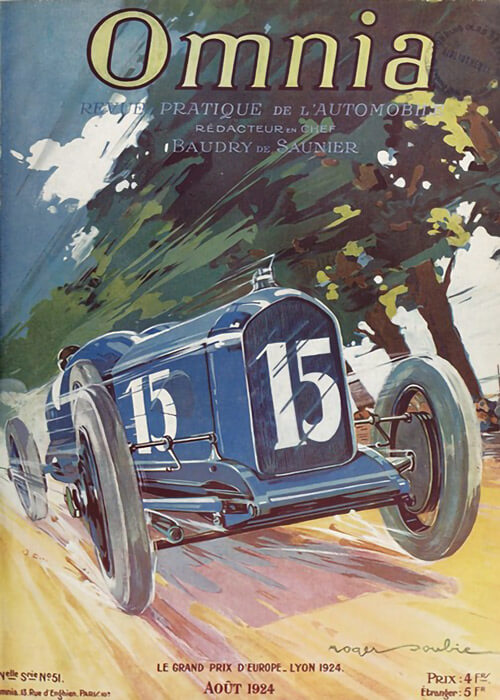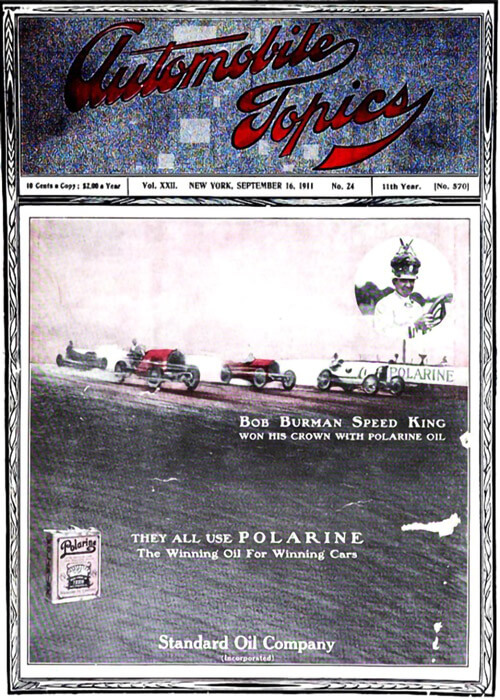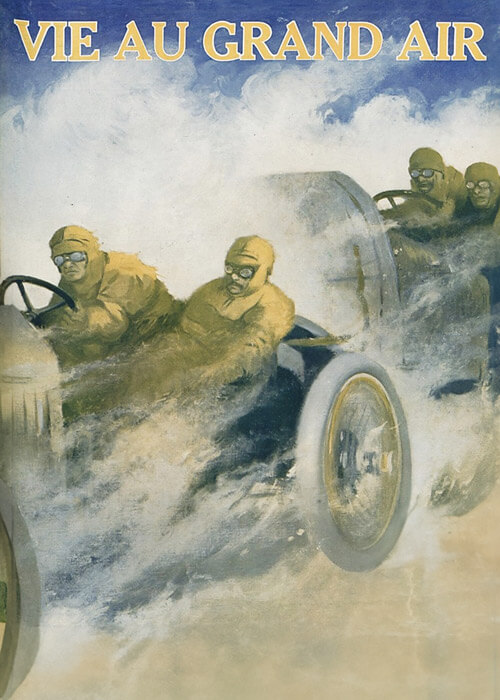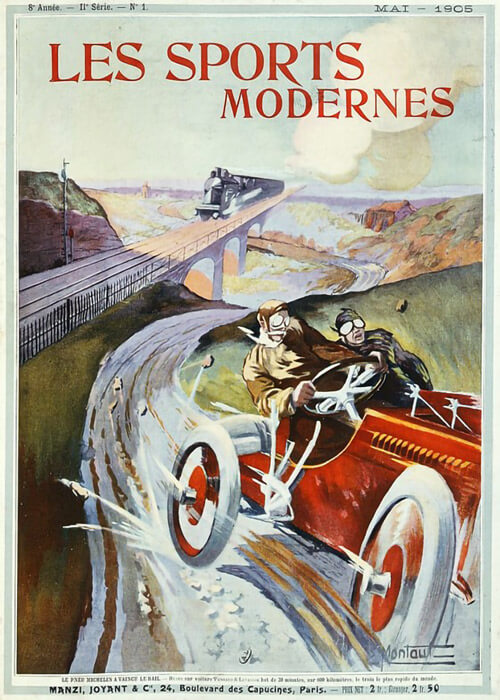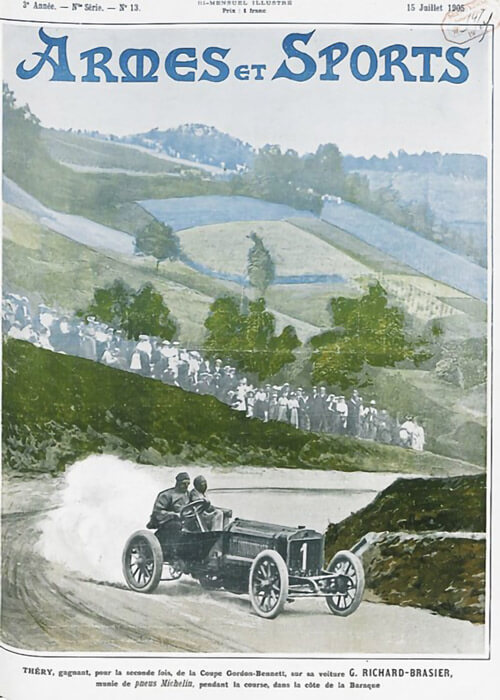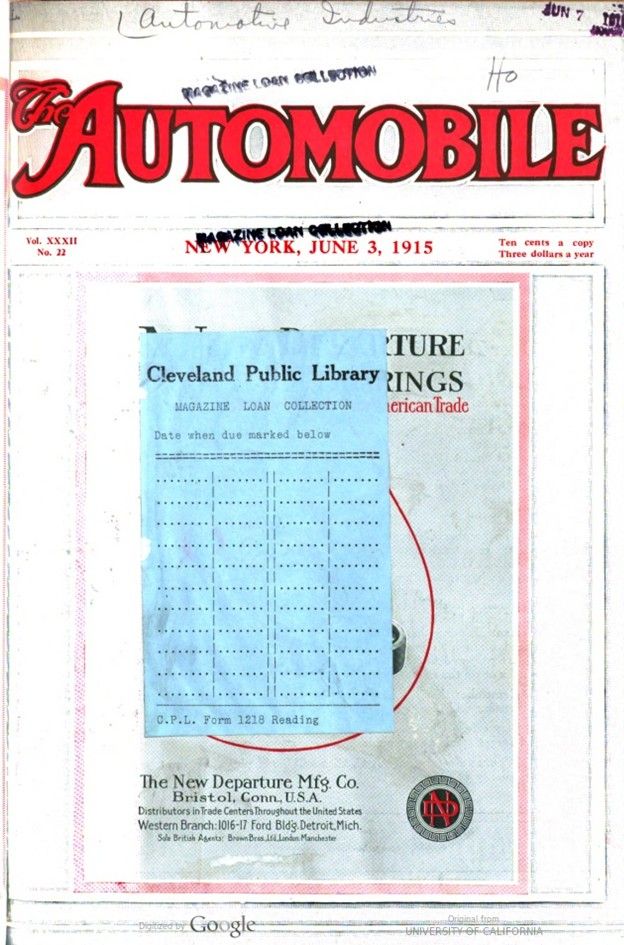
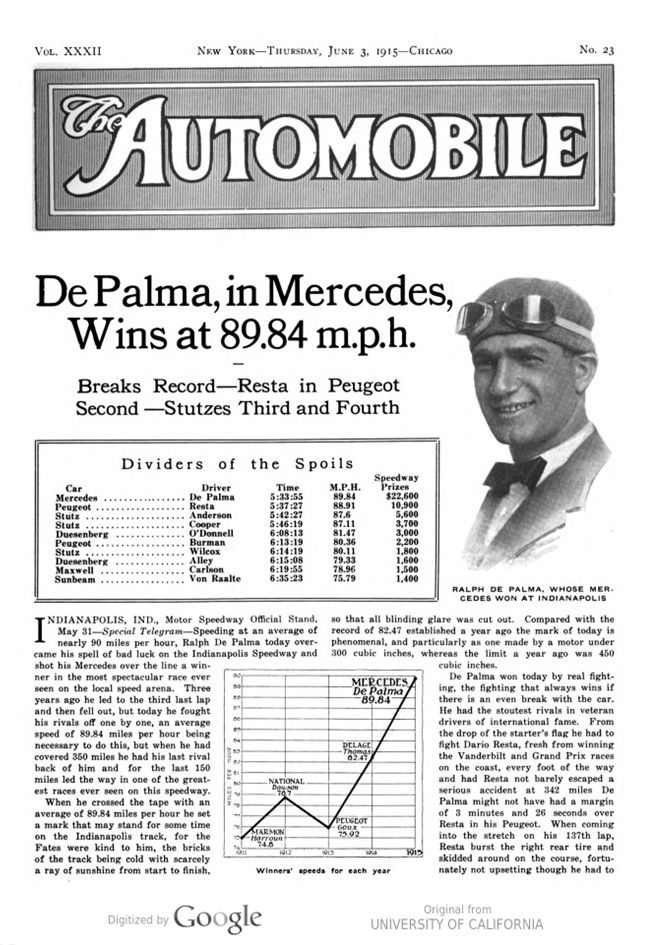


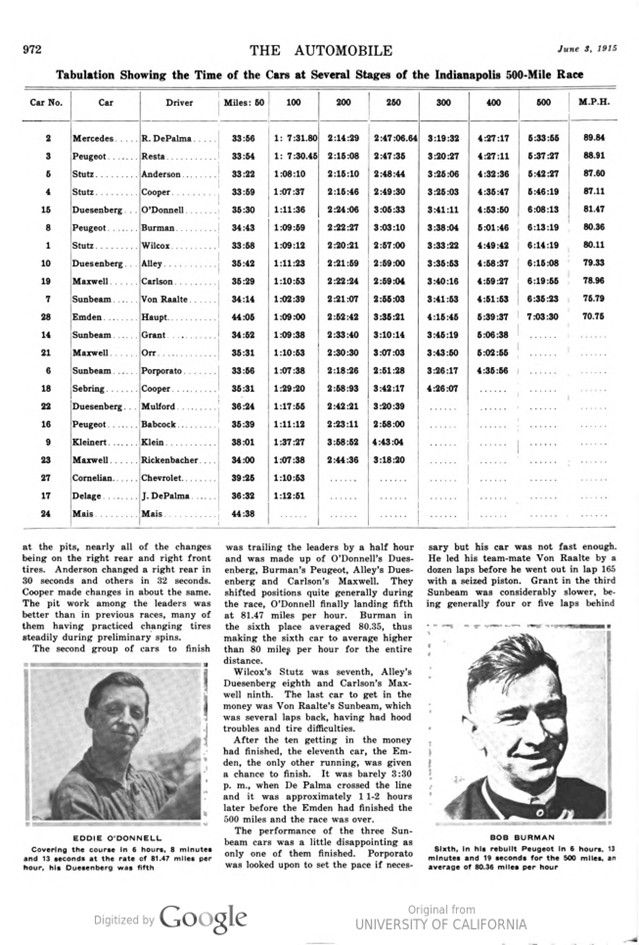
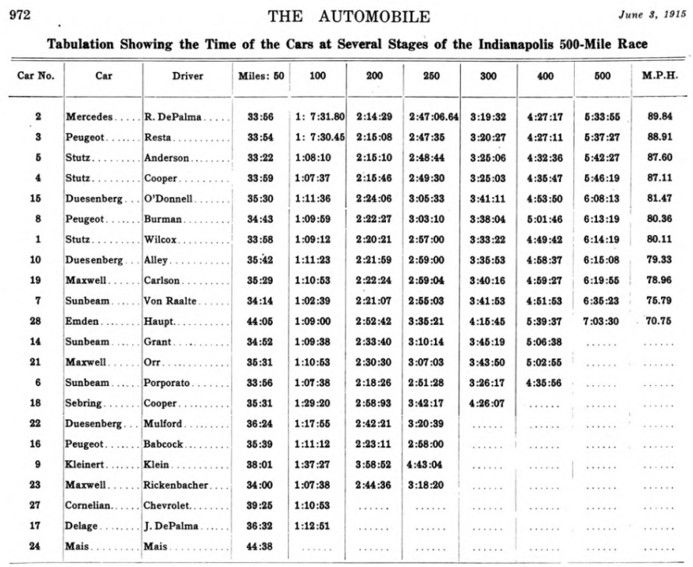
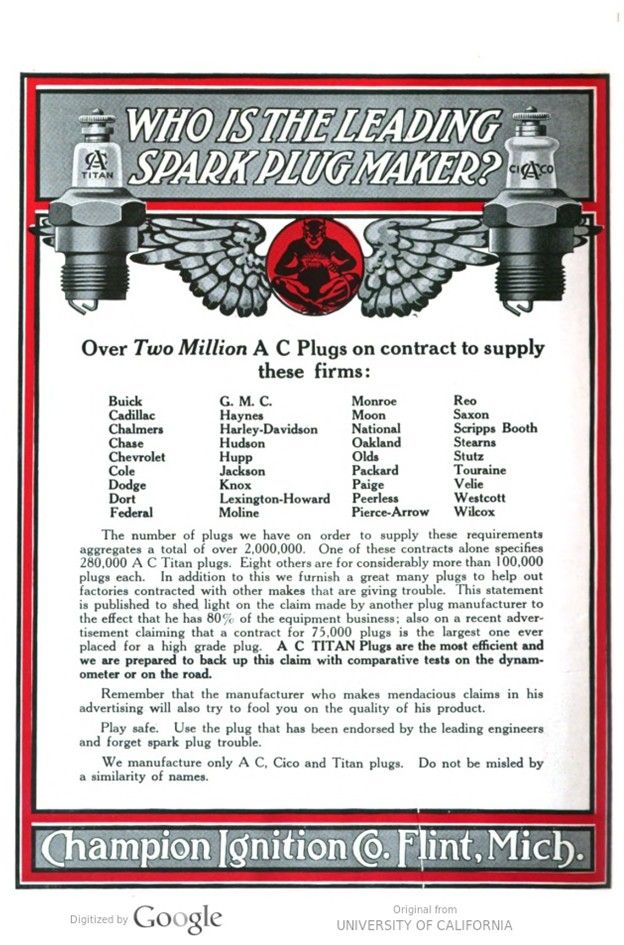
Text and jpegs by courtesy of hathitrust.org www.hathitrust.org, compiled by motorracinghistory.com
The Automobile, Vol. 32, No. 23, June 3, 1915, p. 969 – 977
De Palma, in Mercedes, Wins at 89.84 m.p.h.
Breaks Record – Resta in Peugeot Second – Stutzes Third and Fourth
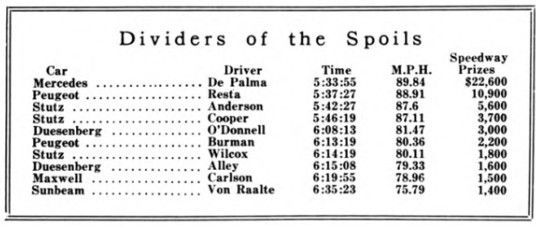
INDIANAPOLIS, IND., Motor Speedway Official Stand, May 31 – Special Telegram-Speeding at an average of nearly 90 miles per hour, Ralph De Palma today overcame his spell of bad luck on the Indianapolis Speedway and shot his Mercedes over the line a winner in the most spectacular race ever Three seen on the local speed arena. years ago he led to the third last lap and then fell out, but today he fought his rivals off one by one, an average speed of 89.84 miles per hour being necessary to do this, but when he had covered 350 miles he had his last rival back of him and for the last 150 miles led the way in one of the greatest races ever seen on this speedway. When he crossed the tape with an average of 89.84 miles per hour he set a mark that may stand for some time on the Indianapolis track, for the Fates were kind to him, the bricks of the track being cold with scarcely a ray of sunshine from start to finish, so that all blinding glare was cut out. Compared with the record of 82.47 established a year ago, the mark of today is phenomenal, and particularly as one made by a motor under 300 cubic inches, whereas the limit a year ago was 450 cubic inches.
De Palma won today by real fighting, the fighting that always wins if there is an even break with the car. He had the stoutest rivals in veteran drivers of international fame. From the drop of the starter’s flag he had to fight Dario Resta, fresh from winning the Vanderbilt and Grand Prix races on the coast, every foot of the way and had Resta not barely escaped a serious accident at 342 miles De Palma might not have had a margin of 3 minutes and 26 seconds over Resta in his Peugeot. When coming into the stretch his 137th lap, Resta burst the right rear tire and skidded around on the course, fortunately not upsetting though he had to stop at the pit and change all four tires, allowing De Palma, who was then trailing him a lap, to jump into the lead. Before Resta was back on the course, De Palma had gained a lap and was set- ting a pace of over 90 miles per hour. Resta’s steering gear had worked loose and he was not able again to catch up with the flying Mercedes, his pace slowing several seconds per lap.
An Uphill Fight
To win it was necessary for De Palma to fight an uphill battle for the first 350 miles. It was a struggle against the Stutz organization and against Resta’s Peugeot, if not one, then the other, with scarcely a let-up and positions often changing every few laps due to stops being made for tire troubles.
From the drop of the flag, Resta, who was in the front row in starting, took the lead and held it for only a lap, when Wilcox driving No. 1 Stutz, jumped into the lead and held it by a small margin for 10 miles. Then his running mate, Anderson, took it and held it for 70 miles. Anderson set one of the hottest of paces for his half dozen pursuers who were bunched never more than a few lengths back of him, hungry for his honors as the hounds are when after the hare.
Resta to the Front
It was the irresistible Resta who finally overtook him when 82 miles were covered and held to the fore for 17 miles. It was in lap 58 or at 145 miles before De Palma ever got a chance to show in front. All of the time up to this point he was battling for position in the first group. In one lap he was third, the next he was back to fourth, then he was up to third or second, but never in first place. It was not until nearly the 100-mile mark was reached that he got firmly established in second place and it took nearly 50 miles more before he got into first place, for Resta was leading at 150 miles. De Palma displaced him at 175 and held first until 325 miles were covered when a stop for tires placed Resta again in front, but it was only for a short time, the skidding accident soon putting De Palma again in the lead and he was never headed off afterwards.
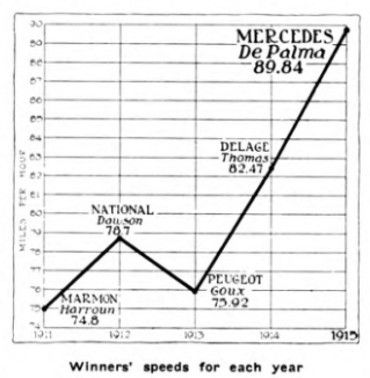


A Narrow Margin
De Palma was playing in the greatest of luck to finish and win. When he finished amid the deafening cheers of tens of thousands, few knew that on the third last lap a connecting-rod had let go and punched two holes in the crankcase. He slowed up perceptibly but gave no evidences of distress other than the usual sound of a missing cylinder. It is a coincidence that 3 years ago he went out in the third last lap and that misfortune should pursue him in this lap today. His troubles 3 years ago were due to a connecting-rod letting go.
America’s Showing Better
America came out much better today than a year ago when all of the first places were captured by the foreign contingent. Today the team of three Stutz cars gave a most amazing account of themselves, all three finishing within the money and two of them finishing third and fourth, a record for new cars which stands unequalled in racing history. Gil Anderson finished third a little over 8 minutes back of the leader and at an average of 87.60 miles per hour, while his team-mate, Earl Cooper, landed in fourth place, six minutes back of him.
Anderson’s performance was spectacular, as he led for 70 miles in the earlier stages of the race, and then battled at every turn until the starter’s flag ended the race. After taking the lead in the sixth lap he set a pace that soon put him well out in front, and maintained this until lap 34 when he stopped to change two outside tires and allowed the other When he got on leaders to pass him, the track again the leaders, Resta and De Palma, were nearly a minute ahead of him and he never got back into first or second place though he was always within close striking distance. The hoods were not raised on either of these two Stutz cars from start to finish and they ran with spectacular regularity.
The third Stutz, piloted by Wilcox, I met with early difficulties and did not maintain the reputation it made for itself in eliminations, when it made the fastest lap. Wilcox was close behind Resta at the end of the first lap and was in the lead in the second lap and held it until the end of the fifth when he dropped back with valve trouble, it being reported that a valve spring had broken. Thus handicapped he drove to the end of the race and finished in seventh place, averaging 79.65 miles per hour.
For the first time in its history dry speedway weather was not on the calendar and the race which was to have been run on Saturday was postponed until today. Indianapolis for the last week has been a rain zone, rain falling nearly steadily day and night. It was doubtful if it would be possible to run the race today. A Scotch mist was blowing across the track before starting, but as the day progressed the wind rose and finally an hour before the finish the sun began breaking through the clouds. Attendance was not up to a year ago, perhaps scarcely more than one-half. Much of the parking space being too soft for cars grandstand privileges were extended to them.
Duel Between Leaders
Today’s battle between De Palma’s Mercedes and Resta’s Peugeot brings to mind the Grand Prize race a year ago in France, where these two cars did battle in one of France’s greatest road races and when the Mercedes triumphed as it did today. From point of speed, Resta had a slight advantage on De Palma, being able to pass him on the stretches but losing out on the turns which De Palma drives in a superior way. For lap after lap these two veterans circled the 2 1-2-mile brick track not a length apart, one lap Resta leading in the stretch, losing it in the turns and again gaining it before crossing the tape. Lap after lap those in the grandstand rose and cheered as their favorites took the leadership. It was one of the grandest speed duels ever seen on the speedway, a duel fought at the pace of over 90 miles an hour. Had Resta not skidded on the turn entering the home stretch it might have continued much longer, but tires can only endure such a pace for a limited time, and first De Palma had to stop and change tires, and then Resta stopped and changed all four, taking on supplies at the same time.
Record-Breaking Pace
Before the race started it was known there were eight or ten cars that were capable of setting a pace hotter than any ever known on the Speedway and from the start this was apparent. These were De Palma (Mercedes); Resta (Peugeot); Wilcox (Stutz); Cooper (Stutz); Anderson (Stutz); Rickenbacher (Maxwell); and perhaps Porporato (Sunbeam).
For the first 100 miles these seven were in a group not spaced from each other by more than a couple of lengths, sometime running side by side and at other time linked out in sheep fashion. On the fourth lap Wilcox led by 1-2 second and the others were all bunched; the next lap they were closer; a lap later and the leader was out in front with the others battling for positions and so the duel went on lap after lap for more than 100 miles, first one losing position for tires and then another.
When Anderson got into the lead in the sixth lap for a time he opened a gap which widened to 100 yards; this was opened to half the length of the home-stretch. He was making lap after lap in 1:40, a pace of 90 miles an hour. Soon he had 25 seconds lead, the next lap it was 26, then 30, then 35, then 37, then 42. He was in an enviable position alone on the track with the fighting rivals a mile back until tire troubles overcame him.
Little Tire Trouble
Both Resta and De Palma made but two stops each, both for tires, and neither had any mechanical troubles from start to finish. De Palma consumed 3 minutes and 23 seconds as compared with 3 minutes and 19 seconds by Resta. De Palma’s first stop at 157 miles was to change the two outside tires and his second stop at 300 miles was to change all four tires and take on supplies. Resta’s changes were made at the same times, but Resta changed all four at each stop.
Pit Work Shows Improvement
Anderson lost 7 minutes and 2 seconds at the pit, making eight stops for tires and fuel. He changed the right tires at 85 miles, and then made changes at more or less regular intervals up to the finish. His running mate, Cooper, had better fortune, losing only 5 minutes at the pits, nearly all of the changes being on the right rear and right front tires. Anderson changed a right rear in 30 seconds and others in 32 seconds. Cooper made changes in about the same. The pit work among the leaders was better than in previous races, many of them having practiced changing tires steadily during preliminary spins.
The second group of cars to finish was trailing the leaders by a half hour and was made up of O’Donnell’s Duesenberg, Burman’s Peugeot, Alley’s Duesenberg and Carlson’s Maxwell. They shifted positions quite generally during the race, O’Donnell finally landing fifth at 81.47 miles per hour. Burman in the sixth place averaged 80.35, thus making the sixth car to average higher than 80 miles per hour for the entire distance.
Wilcox’s Stutz was seventh, Alley’s Duesenberg eighth and Carlson’s Maxwell ninth. The last car to get in the money was Von Raalte’s Sunbeam, which was several laps back, having had hood troubles and tire difficulties.
After the ten getting in the money had finished, the eleventh car, the Emden, the only other running, was given a chance to finish. It was barely 3:30 p. m., when De Palma crossed the line and it was approximately 11-2 hours later before the Emden had finished the 500 miles and the race was over.
The performance of the three Sunbeam cars was a little disappointing as only one of them finished. Porporato was looked upon to set the pace if necessary but his car was not fast enough. He led his team-mate Von Raalte by a dozen laps before he went out in lap 165 with a seized piston. Grant in the third Sunbeam was considerably slower, being generally four or five laps behind Von Raalte. Until he went out, Porporato was running three or four laps back of the leader. He was doing laps in 1.40, a speed of 90 miles an hour, but his difficulty was in keeping up this pace. Grant was slower, taking 1.48 to the lap. Grant had trouble first with a broken brake connection which the technical committee insisted on being repaired and later when the mud apron worked loose and he was flagged to repair it. He withdrew with but fifteen laps to go but running 55 miles back of the leader.
The three Maxwell cars suffered troubles, only one finishing, namely, Carlson, who landed in ninth place. At the start Rickenbacher driving the sixteen-valve motor was among the leaders but spark-plug troubles set in and he could not keep the cylinders supplied and the car was finally put out with a broken connecting-rod at 250 miles. Orr, driving another Maxwell, broke a bearing in the rear axle and was out when the race was in its last stages.
Of the other cars that started, the little Cornelian went out with a broken valve at 180 miles. Before going out, the car ran out of gasoline on the back stretch and lost much time. The Kleinart loosened the partition between the gasoline and oil tanks, letting the two mingle and practically lost its standing. It was later taken out for smoking. The Sebring, Delage, Mais, Bugatti, and Purcell were all out early in the race.
Equipment of the Cars
Bosch had 100 per cent. in the ignition line, every one of the twenty-four starters using Bosch magnetos, seventeen starters using the two-spark type and seven the single-spark, those employing the two-spark system being Stutz, Mercedes, Duesenbergs, Maxwells and three others.
In the way of radiator indicators, every car in the race was fitted with a Motometer.
While Silvertown cord tires did not have a 100 per cent. equipment, yet they were used on all of the ten cars to finish in the money and on the eleventh car which completed the 500 miles. It was an unqualified victory for them. The winning Mercedes used a Packard carbureter, Bosch plugs and Rudge-Whitworth wire wheels.
Resta used a Zenith carbureter and Rudge wheels. On all three Stutzes the Stromberg carbureter was used and Houk wire wheels. The Master carbureter was used by Burman and three others. The Schebler was used on O’Donnell’s Duesenberg.
In the way of lubricating oil, Oilzum was used by practically every car in the race, Ralph De Palma’s Mercedes using Monogram, while the three Sunbeams, driven by Porporato, Von Raalte and Grant used castor.

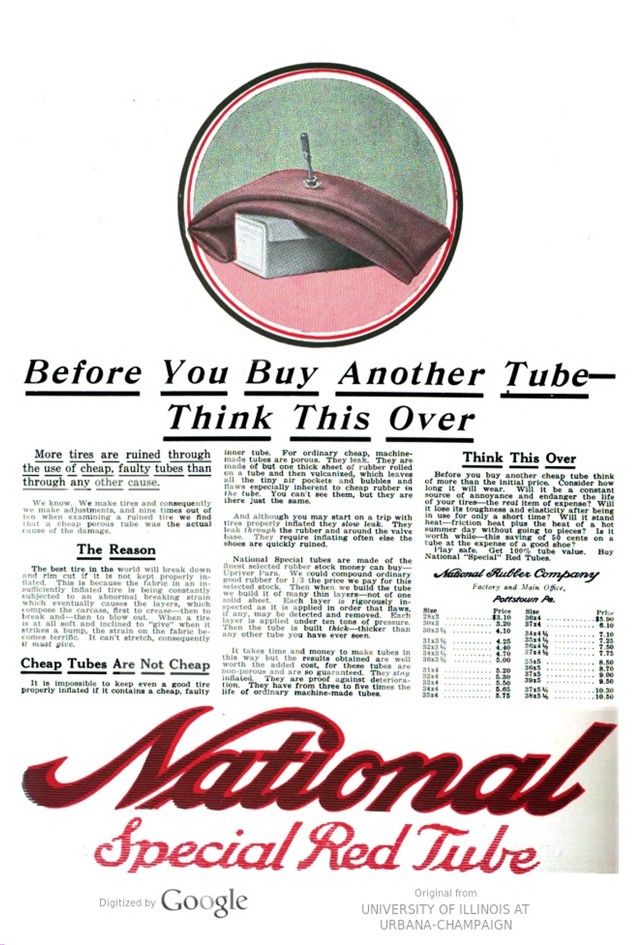


Photo captions. – June 3, 1915 – The Automobile
Page 969 – RALPH DE PALMA, WHOSE MERCEDES WON AT INDIANAPOLIS
Page 970
DARIO RESTA – Who finished second in the Indianapolis race, sending his Peugeot over the 500-mile course in 5 hours 37 minutes and 27 seconds, or at an average speed of 88.91 miles per hour, which, though it brought but second place in this year’s race, was much faster than the best previous record
GIL ANDERSON – Driver of the first American car to finish in the 500-mile race. His Stutz finished in 5 hours 42 minutes and 27 seconds, making an average of 87.6 miles an hour
Anderson’s Stutz hitting the high spots in the elimination trials for the 500-mile race at Indianapolis
Page 971
The winning car – De Palma at the wheel of his Mercedes which won the Indianapolis 500-mile race at 89.84 miles per hour, breaking all previous records
EARL COOPER – Whose Stutz followed that of his team- mate, Anderson, finishing fourth in 5 hours, 46 minutes and 19 seconds, or at 87.11 miles per hour
Page 972
EDDIE O’DONNELL – Covering the course in 6 hours, 8 minutes and 13 seconds at the rate of 81.47 miles per hour, his Duesenberg was fifth
BOB BURMAN – Sixth, in his rebuilt Peugeot in 6 hours, 13 minutes and 19 seconds for the 500 miles, an average of 80.36 miles per hour
Page 973
Weighing-in Howard Wilcox’s Stutz before the elimination trials. This car finished seventh in the 500-mile race
Tabulation Showing the Time of the Cars at Several Stages of the Indianapolis 500-Mile Race
